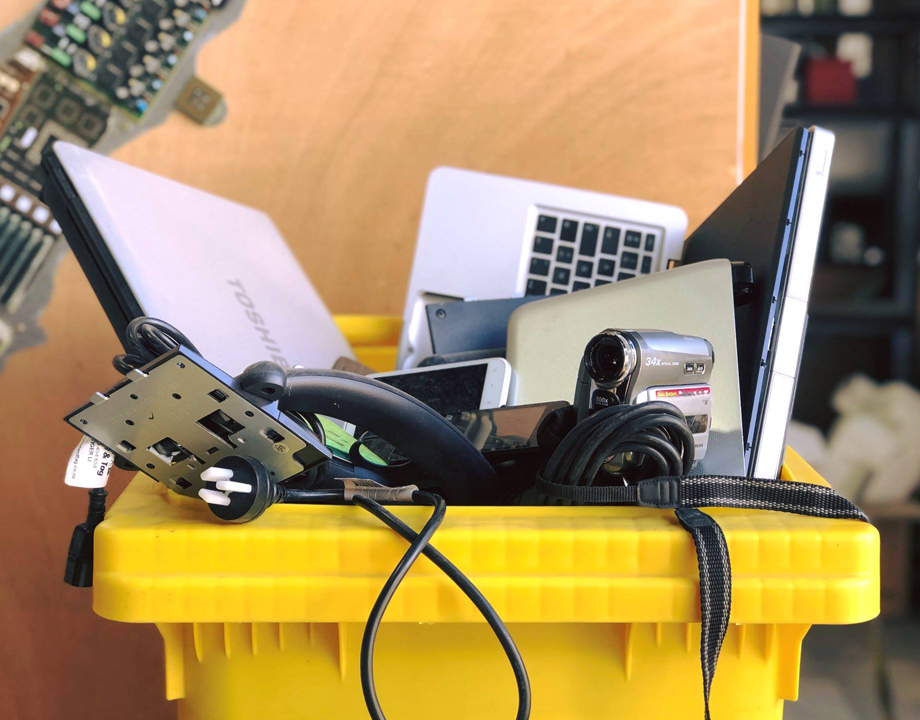Recycling E-Waste Locally
Recycling E-Waste Locally


The current recycling process is expensive and causes pollution. There may be a better method.
Recovering rare earth metals from used electronics is an expensive but necessary endeavor. Recycling used electronics keeps hazardous metals out of the environment, of course. But one part of the recycling dynamic tops even that: separating the special metals from the e-waste stream, while doing so economically and without polluting.
For one researcher, it means creating a recycling process that can be done in local communities, to “recycle locally," and add income and jobs at the local level.
All this turns out to be a big endeavor.
The rare earth metals recovered in recycling are needed to make new electronics, like phones and laptops. The metals—they are the lanthanides on the periodic table—aren’t really rare, but mining and separating them in a tedious process, said Vishnu Sundaresan, who managers the Recycling at Point of Disposal (RPOD) program funded by the U.S. Department of Defense.
Editor’s Pick: A Self-Sustaining Biobattery Keeps the Juice Flowing
So it makes economic and environmental sense to reuse the metals gleaned from outdated devices. But that doesn’t mean electronics recycling is inexpensive. Far from it, said Sundaresan.
The critical elements are a small part of the e-waste stream, about .1 percent to 5 percent, and Sundaresae said the current method used to separate them is inefficient, expensive, and causes pollution.
Today, recovery is mainly done through smelting, separating the materials through melting. The process calls for extremely high temperatures and bringing the metals to those extremes is where most of the expense comes in, he said.
RPOD is backing initiatives—one of them at Iowa State University—intended to recover e-waste metals at a fraction of the current cost and without generating toxic gases or liquids. The RPOD program itself is intended to look at how feasible it is to extract up to seven low-volume fraction elements “that would otherwise be lost as process waste in contemporary recovery techniques,” Sundaresan said.
More for You: Solid State Batteries Drive the Future of the EV Market
This is where Martin Thuo’s team at Iowa State comes in. Thuo, is an associate professor of materials science and engineering.
His team learned in June they’d received RPOD-funding for their recovery process, which was inspired by stalactites and stalagmites growing in caves. Instead of smelting the metals, they de-alloyed them producing what Thuo calls a classic “ship in the bottle,” effect.
De-alloying metals is a way to separate metals and purify them. The process works through controlled applications of oxygen and relatively low temperatures, bringing the most reactive components to the surface in stalagmite-like spikes.
The least-reactive components remain in a purified, liquid core surrounded by brittle metal-oxide spikes that Thuo compares to the classic ‘ship-in-a-bottle’ structure. In that way, the metals are separated.
“The structure formed when the metal is molten is analogous to filled cave structures such as stalactites or stalagmites,” Thuo said.
More on Batteries: Harnessing 5G’s Excess Energy Could End Battery Power
Stalactites and stalagmites form with water, while the researchers use oxidation to create these structures.
The oxidation technology works at temperatures of 500 to 700 degrees Fahrenheit, which is far below the temperatures needed for smelting e-waste, Thuo said.
Thuo has a vision for his e-waste recovery process, even though work on it is just beginning. He wants the process to be done in towns and cities rather than being outsourced to larger companies. In other words, he wants the profits to stay local.
The equipment would be relatively easy to install and the process doesn’t require a large footprint, Thuo said.
The days of environmentally safe, relatively inexpensive recycling of e-waste aren’t yet here, but when they arrive Thuo wants the to benefit local, rather than distance, economies.
Jean Thilmany is a science and technology writer in Saint Paul, Minn.
For one researcher, it means creating a recycling process that can be done in local communities, to “recycle locally," and add income and jobs at the local level.
All this turns out to be a big endeavor.
The rare earth metals recovered in recycling are needed to make new electronics, like phones and laptops. The metals—they are the lanthanides on the periodic table—aren’t really rare, but mining and separating them in a tedious process, said Vishnu Sundaresan, who managers the Recycling at Point of Disposal (RPOD) program funded by the U.S. Department of Defense.
Editor’s Pick: A Self-Sustaining Biobattery Keeps the Juice Flowing
So it makes economic and environmental sense to reuse the metals gleaned from outdated devices. But that doesn’t mean electronics recycling is inexpensive. Far from it, said Sundaresan.
The critical elements are a small part of the e-waste stream, about .1 percent to 5 percent, and Sundaresae said the current method used to separate them is inefficient, expensive, and causes pollution.
Today, recovery is mainly done through smelting, separating the materials through melting. The process calls for extremely high temperatures and bringing the metals to those extremes is where most of the expense comes in, he said.
RPOD is backing initiatives—one of them at Iowa State University—intended to recover e-waste metals at a fraction of the current cost and without generating toxic gases or liquids. The RPOD program itself is intended to look at how feasible it is to extract up to seven low-volume fraction elements “that would otherwise be lost as process waste in contemporary recovery techniques,” Sundaresan said.
More for You: Solid State Batteries Drive the Future of the EV Market
This is where Martin Thuo’s team at Iowa State comes in. Thuo, is an associate professor of materials science and engineering.
His team learned in June they’d received RPOD-funding for their recovery process, which was inspired by stalactites and stalagmites growing in caves. Instead of smelting the metals, they de-alloyed them producing what Thuo calls a classic “ship in the bottle,” effect.
De-alloying metals is a way to separate metals and purify them. The process works through controlled applications of oxygen and relatively low temperatures, bringing the most reactive components to the surface in stalagmite-like spikes.
The least-reactive components remain in a purified, liquid core surrounded by brittle metal-oxide spikes that Thuo compares to the classic ‘ship-in-a-bottle’ structure. In that way, the metals are separated.
“The structure formed when the metal is molten is analogous to filled cave structures such as stalactites or stalagmites,” Thuo said.
More on Batteries: Harnessing 5G’s Excess Energy Could End Battery Power
Stalactites and stalagmites form with water, while the researchers use oxidation to create these structures.
The oxidation technology works at temperatures of 500 to 700 degrees Fahrenheit, which is far below the temperatures needed for smelting e-waste, Thuo said.
Thuo has a vision for his e-waste recovery process, even though work on it is just beginning. He wants the process to be done in towns and cities rather than being outsourced to larger companies. In other words, he wants the profits to stay local.
The equipment would be relatively easy to install and the process doesn’t require a large footprint, Thuo said.
The days of environmentally safe, relatively inexpensive recycling of e-waste aren’t yet here, but when they arrive Thuo wants the to benefit local, rather than distance, economies.
Jean Thilmany is a science and technology writer in Saint Paul, Minn.



